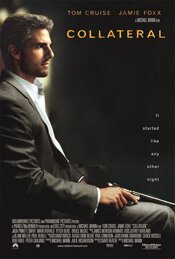 Directed by Michael Mann
Directed by Michael Mann
The only person in Collateral that seems at home in the urban environment is the predator Vincent (Tom Cruise) and, ironically, he’s the only one who says he doesn’t like it (“too sprawled out; too disconnected”).
This is a movie about disconnection.
Director Michael Mann gives us a vision of the city that suggests it’s the natural environment of a sociopathic killer because he’s a predator. Vincent is the only one that recognizes and accepts the lack of connections.
Mann’s Collateral is remarkably quiet. And it’s pace is almost leisurely. It’s fitting, too, since the majority of the movie’s drama occurs at night. It’s nocturnal.
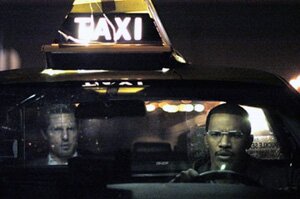
Max (Jamie Foxx) is a cab driver working the night shift. He dreams of his own limo business. But everything must be perfect for that. In the meantime, he drives a cab. He’s been driving a cab for twelve years, but it’s “temporary.”
Then he picks up a fare. It turns out that fare is a hired killer, Vincent, with five stops to make, followed by a trip to the airport. Max can drive him all night for $600 plus an additional $100 if he gets Vincent to the airport soon enough.
Max accepts. But he doesn’t know what Vincent does for a living — yet.
He very quickly, and shockingly, does. He gets the “cold water in the face” treatment. Vincent’s first target lands on his windshield.
With a theme of disconnection, the movie is inevitably about isolation. As a predator, this is how Vincent kills his victims. He isolates them. It’s only later in the film, when he goes after the fourth person on his to-do list that he’s unable to isolate his victim. The result is chaos and the beginning of the end for Vincent.
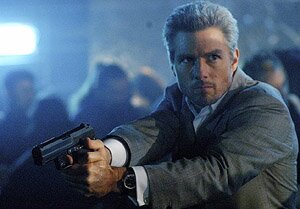
How Mann manages action is worth watching. He takes a Sergio Leone approach but without the elaborate choreography. There are violent scenes but they are abrupt and quickly over, reflecting Vincent’s deadly, predator approach. He’s focused and fast. It’s only in that fourth killing, and the movie’s finale, when Vincent has lost control that the violence stretches out.
Mann’s style in the movie fits his theme perfectly and he adds touches everywhere to highlight disconnection, isolation and the ritual of predator and prey. Even at the movie’s start, when Max first gets in his cab, as he shuts the door he isolates himself from the noise and chaos of the taxicab garage. We see (or rather, “hear”) this repeatedly.
As Max drives, Mann gives us overhead shots of the cab going down a street. It’s utterly silent giving a sense of detachment. His use of sound reflects disconnection and isolation; the way scenes are set and characters are placed reflect it as well. The city we see is, as Vincent says at the start, sprawling. Despite its huge population, Mann gives us scenes where people are strikingly alone and dwarfed by the expanse of their surroundings.
We only see clusters of people when they gather in nodes, like clubs. Beyond those dens they are isolated, alone in an urban expanse of roads, parking lots and concrete buildings.
In the final scenes, when Vincent is going after the fifth person on his list, Annie (Jada Pinkett Smith), we see her in the law office library — large, sprawling and Annie isolated and trapped. Perfect prey for the predator.

However, as we saw in the chaos of the fourth victim’s death, Vincent has lost control. He has needled Max, mocking him with reality, to the point where Max is no longer willing to be a victim. In a sense, Max is now predator as well, only his prey is Vincent. The dynamics have changed for Vincent. His target won’t be isolated long; she and Max are about to become a pack.
But before they do we see Max having to overcome barriers of disconnection (cell phone signal and battery) and reduce the physical distance that separates Annie, himself and Vincent. (Notice how many glass barriers are in the movie — the cab’s windshield, inside the cab separating back seat and front and in the law offices.)
I’m intrigued by the character of Vincent as portrayed by Tom Cruise in the movie. There are scenes, such as when Max refers to him as a sociopath, saying he’s someone missing basic elements normal people have like empathy, where he looks lost and puzzled by Max and people generally. He can’t understand them.
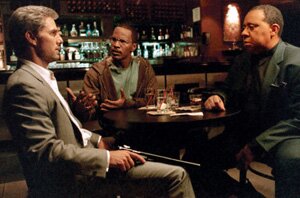
We also see it at the end in the subway train as he is dying. Something is missing in him and he can’t figure out why or whether it is a good or bad thing. He’s just lost.
I think he suspects there is no point to his life beyond survival. He can’t make a leap to answer the next question, what is the point of survival?
He is also lost because, though a predator, he is also a pack animal, but one without a pack and that strips his life of meaning.
At the risk of beating the point and Mann’s imagery, Vincent acts as a lone wolf or coyote. However, wolves and coyotes are both pack animals and that may be why he has those moments of looking lost or confused, sensing that lack of meaning. When Max finally takes action he is, in a sense, protecting his pack.
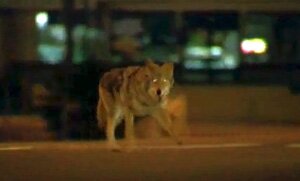
There is a scene in the movie where we see Vincent mesmerized by a coyote that passes in front of the stopped cab. I think it’s a key scene in the movie the detail of which is easily missed.
You may think that, like Vincent, it is a lone animal out looking for prey. But if you look closely at the scene you’ll see it is two coyotes — a pack. One trots across the street quickly and the eyes of Max and Vincent follow it. Then their eyes return to the original direction they were looking in and another coyote, this one moving more slowly, crosses in front of them and their eyes follow it too.
But it is two coyotes, not one, and if Vincent identifies with it he makes the mistake of missing the significance of the pack. It is as packs coyotes (and wolves) isolate their prey; they work together. Vincent’s mistake, and downfall, is in not understanding this. By acting as a lone predator, when things go wrong he is the one isolated. (Why is his fourth victim so difficult to kill? He is in a clustered group of people and surrounded by his own pack (bodyguards) while at the same time another pack, the police, are hunting him.)
The image of the coyote doesn’t represent Vincent. The image of the coyotes (plural) represents what is wrong with him.
Maybe this is the point of Collateral and why the city is portrayed as it is with all its barriers to connection. We’re pack animals and Vincent never gets this.


